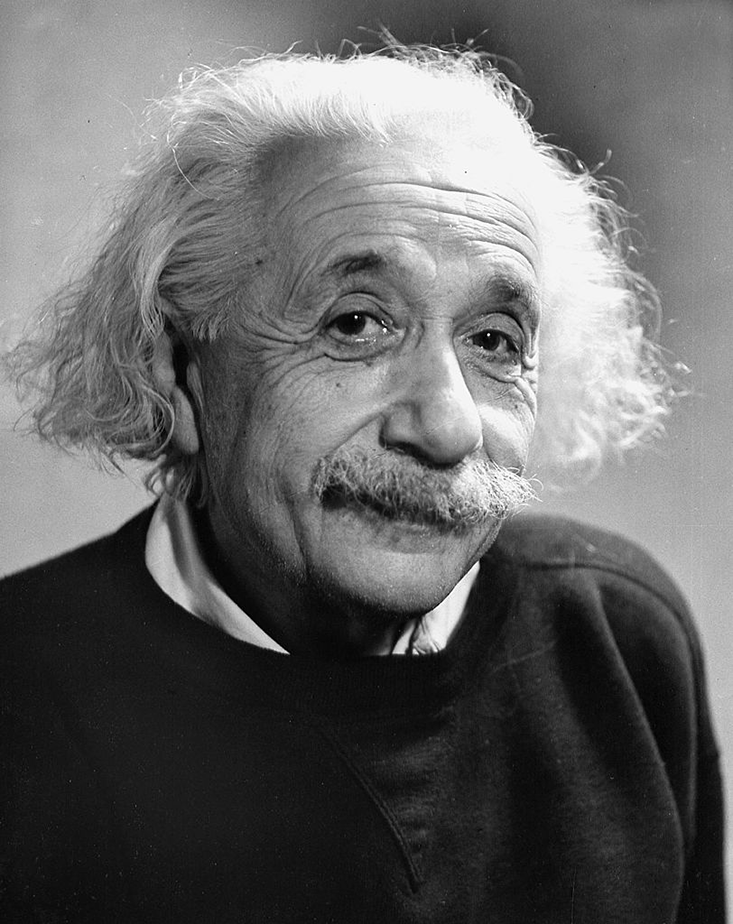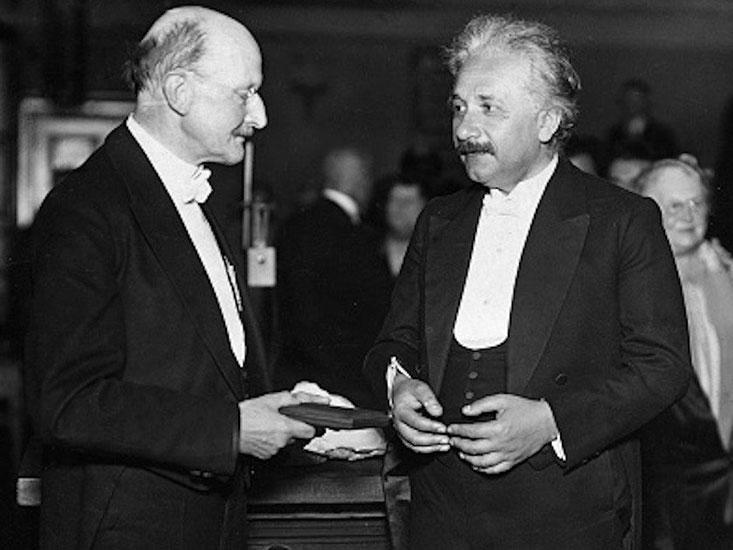On April 6, 1922, Einstein met a man he would never forget. He was one of the most celebrated philosophers of the century, widely known for espousing a theory of time that explained what clocks did not: memories, premonitions, expectations, and anticipations. Thanks to him, we now know that to act on the future one needs to start by changing the past. Why does one thing not always lead to the next? The meeting had been planned as a cordial and scholarly event. It was anything but that. The physicist and the philosopher clashed, each defending opposing, even irreconcilable, ways of understanding time. At the Société française de philosophie—one of the most venerable institutions in France—they confronted each other under the eyes of a select group of intellectuals. The “dialogue between the greatest philosopher and the greatest physicist of the 20th century” was dutifully written down.1 It was a script fit for the theater. The meeting, and the words they uttered, would be discussed for the rest of the century.
The philosopher’s name was Henri Bergson. In the early decades of the century, his fame, prestige, and influence surpassed that of the physicist—who, in contrast, is so well known today. Bergson was compared to Socrates, Copernicus, Kant, Simón Bolívar, and even Don Juan. The philosopher John Dewey claimed that “no philosophic problem will ever exhibit just the same face and aspect that it presented before Professor Bergson.” William James, the Harvard professor and famed psychologist, described Bergson’s Creative Evolution (1907) as “a true miracle,” marking the “beginning of a new era.” For James, Matter and Memory (1896) created “a sort of Copernican revolution as much as Berkeley’s Principles or Kant’s Critique did.” The philosopher Jean Wahl once said that “if one had to name the four great philosophers one could say: Socrates, Plato—taking them together—Descartes, Kant, and Bergson.” The philosopher and historian of philosophy Étienne Gilson categorically claimed that the first third of the 20th century was “the age of Bergson.” He was simultaneously considered “the greatest thinker in the world” and “the most dangerous man in the world.” Many of his followers embarked on “mystical pilgrimages” to his summer home in Saint-Cergue, Switzerland.

Bergson’s reputation was at risk after he confronted the younger man. But so was Einstein’s. The criticisms leveled against the physicist were immediately damaging. When the Nobel Prize was awarded to Einstein a few months later, it was not given for the theory that had made the physicist famous: relativity. Instead, it was given “for his discovery of the law of the photoelectric effect”—an area of science that hardly jolted the public’s imagination to the degree that relativity did. The reasons behind the decision to focus on work other than relativity were directly traced to what Bergson said that day in Paris.
The chairman for the Nobel Committee for Physics explained that although “most discussion centers on his theory of relativity,” it did not merit the prize. Why not? The reasons were surely varied and complex, but the culprit mentioned that evening was clear: “It will be no secret that the famous philosopher Bergson in Paris has challenged this theory.” Bergson had shown that relativity “pertains to epistemology” rather than to physics—and so it “has therefore been the subject of lively debate in philosophical circles.”2
Einstein laid down the gauntlet by considering as valid only two ways of understanding time: physical and psychological.
The explanation that day surely reminded Einstein of the previous spring’s events in Paris. Clearly, he had provoked a controversy. These were the consequences. He had been unable to convince many thinkers of the value of his definition of time, especially when his theory was compared against that of the eminent philosopher. In his acceptance speech, Einstein remained stubborn. He delivered a lecture that was not about the photoelectric effect, for which he had been officially granted the prize, but about relativity—the work that had made him a star worldwide but which was now in question.
The invocation of Bergson’s name by the presenter of the Nobel Prize was a spectacular triumph for the philosopher who had lived his life and made an illustrious career by showing how time should not be understood exclusively through the lens of science. It had to be understood, he persistently and consistently insisted, philosophically. Why did two of the greatest minds of modern times disagree so starkly, dividing intellectual communities for years to come?
On that “truly historic” day when the two met, Bergson was unwillingly dragged into a discussion he had explicitly intended to avoid.3 The philosopher was by then much more senior than Einstein. He spoke for about half an hour. He had been prodded by an impertinent colleague, who had been in turn pressured to speak by the event organizer. “We are more Einsteinian than you, Monsieur Einstein,” he said. His objections would be heard far and wide. “Bergson was supposed by all of us to be dead,” explained the writer and artist Wyndham Lewis, “but Relativity, oddly enough at first sight, has resuscitated him.”4
The physicist responded in less than a minute—including in his answer one damning and frequently cited sentence: “Il n’y a donc pas un temps des philosophes.” Einstein’s reply—stating that the time of the philosophers did not exist—was incendiary.
What Einstein said next that evening was even more controversial: “There remains only a psychological time that differs from the physicist’s.” At that very moment, Einstein laid down the gauntlet by considering as valid only two ways of understanding time: physical and psychological. These two ways of examining time, although scandalous in the particular context that Einstein uttered them, had a long history. With Einstein, they would have an even longer one—becoming two dominant prisms inflecting most investigations into the nature of time during the 20th century.
The simple, dualistic perspective on time advocated by Einstein appalled Bergson. The philosopher responded by writing a whole book dedicated to confronting Einstein. His theory is “a metaphysics grafted upon science, it is not science,” he wrote. Einstein’s and Bergson’s contributions appeared to their contemporaries forcefully at odds, representing two competing strands of modern times. Bergson was associated with metaphysics, antirationalism, and vitalism, the idea that life permeates everything. Einstein with their opposites: with physics, rationality, and the idea that the universe (and our knowledge of it) could stand just as well without us. Einstein has since been crowned as the man whose work took “sensorial perception and analytical principles as sources of knowledge,” nothing more and nothing less.
Einstein’s theory of time, argued the philosopher, prevented us from realizing that “the future is in reality open, unpredictable, and indeterminate.”
The theory of relativity broke with classical physics in three main respects: first, it redefined concepts of time and space by claiming that they were no longer universal; second, it showed that time and space were completely related; and third, the theory did away with the concept of the ether, a substance that allegedly filled empty space and that scientists hoped would provide a stable background to both the universe and their theories of classical mechanics.
In combination, these three insights were related to a startlingly new effect, time dilation, which profoundly shocked scientists and the general public. In colloquial terms, scientists often described it by saying that time slowed down at fast velocities and, even more dramatically, that it completely stopped at the speed of light. If two clocks were set at the same time with respect to each other, and if one of them separated from the other traveling at a constant speed, they would mark different times, depending on their respective velocities. Although observers traveling with the clocks would be unable to notice any changes in their own system, one of them was slow in comparison to the other. Researchers calculated a striking difference between “time1” as measured by a stationary clock when compared to “time2” as measured by a clock in motion. Which of these referred to time? According to Einstein, both—that is, all frames of references should be treated as equal. Both quantities referred equally to time. Had Einstein found a way to stop time?

Relativity scientists argued that our common conception of “simultaneity” needed to be upgraded: Two events that seemed to occur simultaneously according to one observer were not necessarily simultaneous for another one. This effect was connected to other aspects of the theory: that the speed of light (in vacuo and in the absence of a gravitational field) was constant. The velocity of most physical objects could successively be increased by piggy-backing on other fast-moving objects.
For example, a train traveling at a certain speed could be made to travel faster if placed on top of another fast train. While the first train could be traveling at, say, 50 mph, the one on top would go at 100 mph, the next one at 150 mph, and so on. Not so with light waves. The speed of light, in Einstein’s account of special relativity, was not only constant; it was an unsurpassable velocity. This simple fact led scientists not only to abandon the concept of absolute simultaneity, it also led them to a host of additional paradoxical effects, including time dilation.
Bergson found Einstein’s definition of time in terms of clocks completely aberrant. The philosopher did not understand why one would opt to describe the timing of a significant event, such as the arrival of a train, in terms of how that event matched against a watch. He did not understand why Einstein tried to establish this particular procedure as a privileged way to determine simultaneity. Bergson searched for a more basic definition of simultaneity, one that would not stop at the watch but that would explain why clocks were used in the first place. If this, much more basic, conception of simultaneity did not exist, then “clocks would not serve any purpose.” “Nobody would fabricate them, or at least nobody would buy them,” he argued. Yes, clocks were bought “to know what time it is,” admitted Bergson. But “knowing what time it is” presupposed that the correspondence between the clock and an “event that is happening” was meaningful for the person involved so that it commanded their attention. That certain correspondences between events could be significant for us, while most others were not, explained our basic sense of simultaneity and the widespread use of clocks. Clocks, by themselves, could not explain either simultaneity or time, he argued.
If a sense of simultaneity more basic than that revealed by matching an event against a clock hand did not exist, clocks would serve no meaningful purpose:
They would be bits of machinery with which we would amuse ourselves by comparing them with one another; they would not be employed in classifying events; in short, they would exist for their own sake and not serve us. They would lose their raison d’être for the theoretician of relativity as for everybody else, for he too calls them in only to designate the time of an event.
The entire force of Einstein’s work, argued Bergson, was due to how it functioned as a “sign” that appealed to a natural and intuitive concept of simultaneity. “It is only because” Einstein’s conception “helps us recognize this natural simultaneity, because it is its sign, and because it can be converted into intuitive simultaneity, that you call it simultaneity,” he explained.5 Einstein’s work was so revolutionary and so shocking only because our natural, intuitive notion of simultaneity remained strong. By negating it, it could not help but refer back to it, just like a sign referred to its object.
Bergson had been thinking about clocks for years. He agreed that clocks helped note simultaneities, but he did not think that our understanding of time could be based solely on them. He had already thought about this option, back in 1889, and had quickly discounted it: “When our eyes follow on the face of a clock, the movement of the needle that corresponds to the oscillations of the pendulum, I do not measure duration, as one would think; I simply count simultaneities, which is quite different.”6 Something different, something novel, something important, something outside of the watch itself needed to be included in our understanding of time. Only that could explain why we attributed to clocks such power: Why we bought them, why we used them, and why we invented them in the first place.
Psychological conceptions of time, Einstein insisted, were not only simply in error, they just did not correspond to anything concrete.
Our perception of the world was not, as commonly thought of, merely contemplative and disinterested, rather it was already shaped by our memories. Both were defined by our sense of what we could act on. Bergson warned his readers that unless they acknowledged the active role played by memories, they would inevitably come back to haunt them: “But if the difference between perception and memory is abolished … we become unable to really distinguish the past from the present, that is, from that which is acting.” The distinction between the past, the present, and the future was determined physically, physiologically, and psychologically.
Einstein’s theory of time, argued the philosopher, was particularly dangerous because of how it treated “duration as a deficiency.” It prevented us from realizing that “the future is in reality open, unpredictable, and indeterminate.” It eliminated real time; that is, “what is most positive in the world.”
During the debate, Einstein explicitly stated what he held to be the purpose of philosophy and why it should not play a role at all with respect to time. In the face of his contradictor, he gave to philosophy a very limited role. He proceeded to explain himself. He mentioned two common ways of thinking about time, psychological and physical. Psychological time was the time perceived by a person, while physical time was time as measured by a scientific instrument, such as a clock. Time as measured by an instrument was often different from time perceived by a person. Factors such as boredom, impatience, or simple psychological changes affected psychological perceptions of time. With the spread of timekeeping devices, the difference between time felt and time measured became increasingly noted. We know, for example by reading the diary of Franz Kafka, that in intimate accounts of that period, an “inner clock” often seemed to disagree from an “outer one.”
But in most cases, physical and psychological conceptions of time did not have to differ too much. Most people could estimate time in a manner that accorded pretty well with that of a clock, determining very precisely the time for breakfast, lunch, and dinnertime. Most people could also judge if two events were simultaneous in a way that accorded pretty well with simultaneity as measured by instruments. But the opposite was true when dealing with very fast events. In these cases (such as during the finish of a horse race), the deficiency of perceptions of simultaneity when compared to simultaneity as determined by an instrument was clear; these determinations differed significantly from those determined with instrumental aides. In a universe marked by events occurring close to the speed of light, the difference between the two was extreme.
According to Einstein, philosophy had been used to explain the relation between psychology and physics. “The time of the philosopher, I believe, is a psychological and physical time at the same time,” he explained in Paris. But relativity, by focusing on very fast phenomena, had shown just how off-the-mark psychological perceptions of time really were.
Psychological conceptions of time, Einstein insisted, were not only simply in error, they just did not correspond to anything concrete. “These are nothing more than mental constructs, logical entities.” Because of the enormous speed of light, humans had “instinctively” generalized their conception of simultaneity and mistakenly applied it to the rest of the universe. Einstein’s theory corrected this mistaken generalization. Instead of believing in an overlapping area between psychological and physical conceptions of time (where both were important although one was admittedly less accurate than the other), he argued that they were really two distinct concepts: a mental assessment (the psychological one) that was wholly inadequate when compared to the “objective” concept: physical time.
Bergson and Einstein accepted that an essential difference existed between psychological and physical conceptions of time, yet they made different deductions from this. For Einstein, this led him to conclude that “the time of the philosophers does not exist, there remains only a psychological time that differs from the physicist’s.”7 For Bergson this lesson—that psychological and physical assessments of time were different—made, on the contrary, the philosopher’s task even more interesting, especially because no one, not even physicists, could avoid the problem of relating time back to human affairs.

In the years that followed, Bergson was largely perceived to have lost the debate against the younger physicist. The scientist’s views on time came to dominate most learned discussions on the topic, keeping in abeyance not only Bergson’s but many other artistic and literary approaches, by relegating them to a position of secondary, auxiliary importance. For many, Bergson’s defeat represented a victory of “rationality” against “intuition.” It marked a moment when intellectuals were no longer able to keep up with revolutions in science due to its increasing complexity. Thus began “the story of the setback, after a period of unprecedented success, of Bergson’s philosophy of absolute time—unquestionably under the impact of relativity.” Most important, then began the period when the relevance of philosophy declined in the face of the rising influence of science.
Biographers who write about Einstein’s life and work rarely mention Bergson. One exception, a book written by a colleague, paints a picture of eventual rapprochement between the two men.8 But other evidence shows just how divisive their encounter was. A few years before their deaths, Bergson wrote about Einstein, and Einstein mentioned Bergson one last time. They underlined—once again—just how wrong the perspective of the other remained. While the debate was for the most part removed from Einstein’s legacy, it was periodically brought up by many of Bergson’s followers. The simple act of reviving the discussion that took place that day in April 1922 was not a matter that could be taken lightly. Not only is the incident itself divisive—its relevance for history is still contested.
Jimena Canales is a professor of history at the University of Illinois at Urbana who writes about the history of science and technology.
References
1. Cariou, M. “Dialogue” Bergson et Bachelard Presses Universitaires de France, Paris (1995).
2. Arrhenius, S. “Presentation Speech,” 10 December 1922 in Nobel Lectures in Physics (1901-1921) World Scientific, Singapore (1998).
3. Benrubi, I. Souvenirs sur Henri Bergson Neuchâtel: Delchaux & Niestlé, Paris (1942).
4. Lewis, W. Time and Western Man Gingko Press, Berkeley, CA (1993).
5. Bergson, H. Durée et Simultanéité Clinamen Press Ltd., Manchester, United Kingdom (1922).
6. Bergson, H. Essai sur les Données Immédiates de la Conscience George Allen & Unwin Ltd., London (1889).
7. Ushenko, P.A. Einstein’s influence on contemporary philosophy. In Schilpp, P.A. (Ed.), Albert Einstein: Philosopher-Scientist Open Court, Chicago (1949).
8. Pais, A. Subtle is the Lord…”: The Science and the Life of Albert Einstein Oxford University Press, New York, NY (1982).
Excerpted from The Physicist and the Philosopher: Einstein, Bergson, and the Debate That Changed Our Understanding of Time by Jimena Canales © 2015 by Princeton University Press. Reprinted by permission.



























